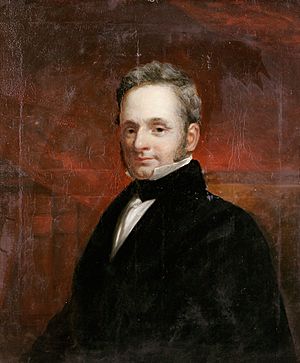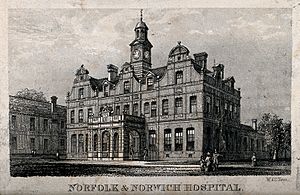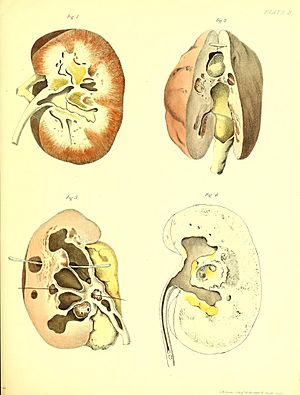John Green Crosse facts for kids
John Green Crosse (born September 6, 1790 – died June 9, 1850) was a famous English surgeon. He worked at the Norfolk and Norwich Hospital.
After learning his first medical skills in Stowmarket, he studied in London. He also spent time learning in Dublin and Paris. In 1815, he settled in Norwich.
He became an assistant surgeon at the Norfolk and Norwich Hospital in 1823. By 1826, he was a full surgeon. He was very skilled at removing bladder stones. In 1836, he became a Fellow of the Royal Society, a group that recognizes top scientists.
Crosse wrote books about his medical experiences. These included Sketches of the Medical Schools of Paris, which described hospitals there. He also wrote about a smallpox outbreak in Norwich. In 1833, he won an important prize for his work on bladder stones.
A Surgeon's Journey: John Crosse's Life
John Crosse was born on September 6, 1790. His family lived at Boyton Hall in Great Finborough, Suffolk. He was the second son of William Cross, a farmer.
When he was young, he became an apprentice to Thomas Bayly. Bayly was a surgeon and apothecary in Stowmarket. An apothecary was like a pharmacist and doctor combined.
After his apprenticeship, Crosse went to London. He studied at St. George's Hospital. He also attended the Windmill Street School of Medicine. A famous surgeon, Benjamin Brodie, then suggested he work in Dublin.
Crosse went to Trinity College, Dublin as a demonstrator. He added an 'e' to his last name around this time. He then traveled to Paris in 1814. He spent the winter there learning more about medicine. In March 1815, he moved to Norwich.
In 1823, Crosse became an assistant surgeon. He worked at the Norfolk and Norwich Hospital. By 1826, he was promoted to surgeon. He became very well-known for his surgical skills. He was especially good at removing bladder stones.
In 1836, Crosse was chosen to be a Fellow of the Royal Society. This was a great honor for his medical work. He taught many students during his career. About 40 apprentices learned from him. One of his students was George Murray Humphry.
In 1827, he was also elected to the American Philosophical Society. This group promotes useful knowledge. Crosse's health began to decline in 1848. He passed away on June 9, 1850. He was buried in the cloisters of Norwich Cathedral.
John Crosse's Important Medical Works
John Crosse wrote letters to his friends in London and Dublin. These letters described how hospitals worked in Paris. When he returned, he published them as a book. It was called Sketches of the Medical Schools of Paris.
He was most interested in anatomy and surgery. He thought London's medical education was better. However, he noted that Paris had good lectures on medical law. London did not have these at the time.
In 1820, he published another important book. It was titled A History of the Variolous Epidemic which occurred in Norwich in the year 1819. This book talked about a smallpox outbreak. It also showed how vaccination was spreading in eastern England.
Crosse worked with his colleague John Yelloly. They studied bladder stones together. Their findings were published in a science journal in 1829 and 1830.
In 1833, he won the Jacksonian prize. This award was from the Royal College of Surgeons of England. He won it for his work on bladder stones. His book was published in 1835. It had drawings by the Norwich artist Obadiah Short.
He also wrote many papers for medical groups. He was president of one such group in 1846. Some of his notes on childbirth were published after he died.
John Crosse's Family Life
John Crosse married Dorothy Bayly on May 18, 1816. Dorothy was the daughter of Thomas Bayly. Thomas Bayly was the surgeon Crosse had apprenticed with in Stowmarket. They were married at the Church of St. Peter and St. Mary in Stowmarket. John and Dorothy had eight children. Their third child was Lavinia Crosse.




